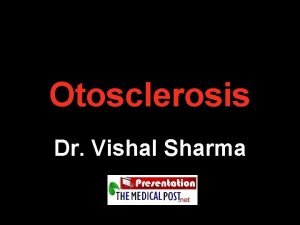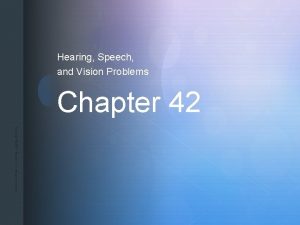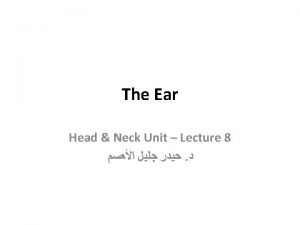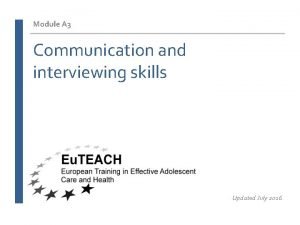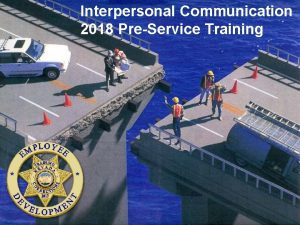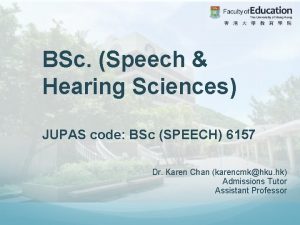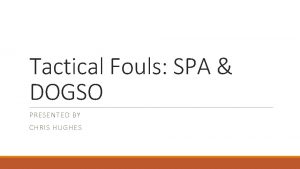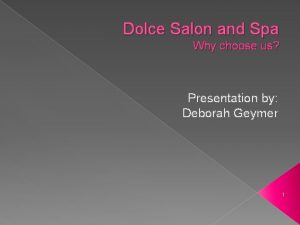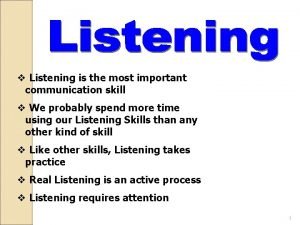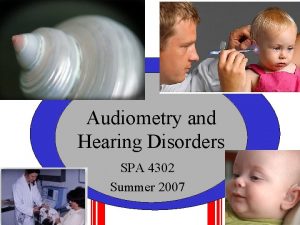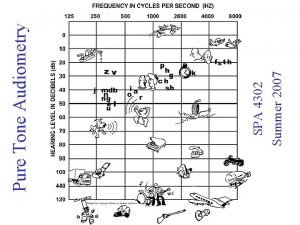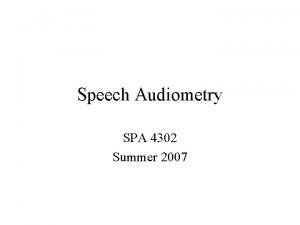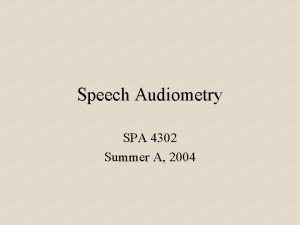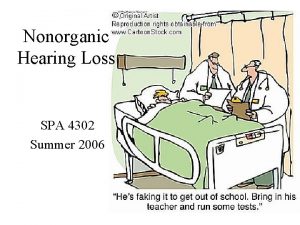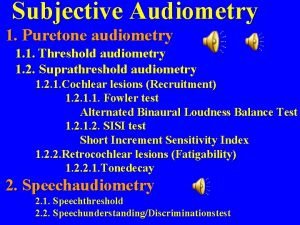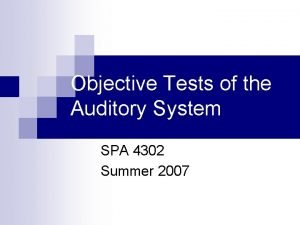Audiometry and Hearing Disorders SPA 4302 Summer A














- Slides: 14

Audiometry and Hearing Disorders SPA 4302 Summer A 2004

The Evolution of Audiology • “Audiology”=audire (Latin=to hear) + logos (Greek=the study of) • Post-World War II—military aural rehabilitation centers for veterans. • Scope of practice grew with changing technology • Educational requirements moved from – Bachelor’s degree – Master’s degree (1960’s) – Doctor of Audiology (1990’s) • Audiologist—an individual who “is uniquely qualified to provide a comprehensive array of professional services related to the assessment and habilitation/rehabilitation of persons with auditory and vestibular impairments, and to the prevention of these impairments” (American Academy of Audiology, 1997)

Prevalence/Impact of Hearing Loss • • • 26 million people have hearing impairment 30 million are regularly exposed to hazardous noise levels 10 million have permanent noise-induced hearing loss 6 out of 1000 children are born with a hearing impairment By age 6, 90% of US children have had at least one ear infection Frequent ear infections can significantly impair speech and language development and academic performance • For older adults, hearing loss can impact personal relationships and is related to overall poor health, decreased physical activity, and depression • Northern and Downs (2002)—for a 1 year-old child with severe hearing impairment and average life expectancy of 75 years, the economic burden can approach $2 million

Audiology Specialties • • • Medical Audiology Educational Audiology Pediatric Audiology Dispensing/Rehabilitative Audiology Industrial Audiology

Where do we work? • Almost 80% of audiologists ID themselves as direct clinical service providers • Most audiologists work within a medical environment (physician’s office, hospitals, etc. ) • The most rapidly growing setting is private practice (largely due to the development of the Au. D. ) • Other settings: – Schools, College/University, Speech & Hearing Center, Residential Home Health Care, Industrial

Professional Societies • American Speech-Language-Hearing Association (ASHA)—first professional society for audiologists (1947) • American Academy of Audiology (AAA)—founded in 1988 • Academy of Rehabilitative Audiology • Academy of Dispensing Audiologists • Educational Audiology Association • American Auditory Society • Self Help for Hard of Hearing People, Inc. • Alexander Graham Bell Association for the Deaf

Anatomy and Physiology of the Ear

Inner Ear

Pathways of Sound • Air Conduction—sound travels through the outer ear, middle ear, inner ear, and neural pathways • Bone Conduction—sound bypasses the outer ear and middle ear by vibrating the skull mechanically and stimulating the inner ear directly

AIR CONDUCTION

Bone Conduction

Types of Hearing Loss • Conductive Hearing Loss – Hearing by air conduction will be impaired, but hearing by bone conduction will be normal • Sensorineural Hearing Loss – Hearing by air conduction and bone conduction will be impaired • Mixed Hearing Loss – Hearing by air conduction and bone conduction will be impaired, but hearing loss will be greater by air conduction

Hearing Tests • Early tests that provided little information: – Clapping the hands – Making various vocal sounds – Ticking of a watch – Clicking 2 coins together

Tuning Fork Tests • First used in the 19 th Century • Tuning forks emit a pure tone at a specific frequency Schwabach Test—hearing sensitivity of a patient vs. that of the tester Rinne Test—patient’s hearing sensitivity by bone conduction vs. by air conduction Bing Test—hearing by bone conduction with/out occlusion Weber Test—lateralization of bone conducted tone: unilateral sensorineural hearing loss-- heard in better ear; unilateral conductive hearing loss – heard in poorer ear
 Flamingo pink sign otosclerosis
Flamingo pink sign otosclerosis Chapter 42 hearing speech and vision problems
Chapter 42 hearing speech and vision problems Hearing and equilibrium
Hearing and equilibrium Bony labrynth
Bony labrynth Beach side sight
Beach side sight Headssss
Headssss Proxemics in communication skills
Proxemics in communication skills Hku speech and hearing
Hku speech and hearing Spa y dogso
Spa y dogso Ecu pool
Ecu pool Varna spa and wellness
Varna spa and wellness Bali relaxing resort and spa
Bali relaxing resort and spa Dolce salon and spa
Dolce salon and spa Types of reflective listening
Types of reflective listening The importance of listening
The importance of listening
